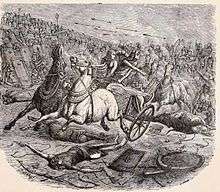Chariotry in ancient Egypt

In ancient Egyptian society chariotry stood as an independent unit in the King’s military force. Chariots were first introduced as a weapon in Egypt by the Hyksos[1] in the 16th century BC. The Egyptians developed their own design of the chariot.
Design
Archaeologist Joost Crouwel writes that "Chariots were not sudden inventions, but developed out of earlier vehicles that were mounted on disk or cross-bar wheels. This development can best be traced in the Near East, where spoke-wheeled and horse-drawn ‘true’ chariots are first attested in the earlier part of the second millennium BC...".[2] The early usage of chariots was mainly for transportation purposes. With technological improvements to their structure (such as a “cross-bar” form of wheel construction to reduce the vehicle's weight), the use of chariots for military purposes began. The Egyptians invented the yoke saddle for their chariot horses around 1500 BC. Chariots were effective for their high speed, mobility and strength which could not be matched by infantry at the time. They quickly became a powerful new weapon across the ancient Near East. The best preserved examples of Egyptian chariots are the six specimens from the tomb of Tutankhamun.
Chariots in warfare

Chariots were very expensive, heavy and prone to breakdowns, yet in contrast with early cavalry, chariots offered a more stable platform for archers. Chariots were also effective for archery because of the relatively long bows used, and even after the invention of the composite bow the length of the bow was not significantly reduced. Such a bow was difficult to handle while on horseback. A chariot could also carry more ammunition than a single rider.
However, the chariot also had several disadvantages, notably its size and its dependence on the right terrain. Their use has been compared to that of tanks in modern day warfare but this is disputed[3][4] by scholars who point out that chariots were vulnerable, fragile and required a level terrain while tanks are all-terrain vehicles. Chariots were thus not suitable for use in the way modern tanks have been used as a physical shock force.[5][6]
Chariots were not able to launch sudden strikes because they made too much noise. It has been argued that early Egyptians may have had no experience of breeding and training horses for military purposes, which may be a reason why so few cavalry served in the ancient Egyptian military. In field action, chariots usually delivered the first strike and were closely followed by infantry advancing to exploit the resulting breakthrough, somewhat similar to how infantry operates behind a group of armed vehicles in modern warfare. This tactic was effective against tight units of spearmen as it allowed holes to be punched in a line which would otherwise be difficult to attack due to its compact nature. In another role, chariots were deployed to pursue and disperse enemies after the victory had been achieved. Egyptian light chariots contained one driver and one warrior, usually wielding a bow or, after depleting all his arrows, a short spear.
In ancient Egypt, members of the chariotry units formed their own aristocratic class known as the maryannu (young heroes). The heroic symbolism can be seen in contemporary paintings in which the King is shown riding with the elites, shooting arrows at the enemies. This image became typical of royal power iconography in the New Kingdom.
The best known and preserved textual evidence about Egyptian chariots in action was from the Battle of Kadesh during the reign of Ramses II; probably the largest single chariot battle of all time.
References
- ↑ Hyskos introduced chariots to ancient Egypt
- ↑ Joost Crouwel (2013). "Studying the Six Chariots from the Tomb of Tutankhamun - An Update". In Veldmeijer, Andre J.; Ikram, Salima. Chasing Chariots: Proceedings of the First International Chariot Conference (Cairo 2012). Sidestone Press. p. 74. ISBN 978-9088902093.
- ↑ Lloyd, Alan B. (2010). A Companion to Ancient Egyp. Wiley Blackwell. p. 438. ISBN 978-1-4051-5598-4.
- ↑ Drews, Robert (1995). The end of the Bronze Age: changes in warfare and the catastrophe ca. 1200 B.C. (new ed.). Princeton University Press. p. 221. ISBN 978-0-691-02591-9.
- ↑ Littauer, M.A.; J. H. Crouwel (1979). Wheeled vehicles and ridden animals in the ancient Near East. Brill. p. 98. ISBN 978-90-04-05953-5.
- ↑ Gaebel, Robert E. Cavalry operations in the ancient Greek world. University of Oklahoma Press. p. 40. ISBN 978-0-8061-3444-4.
